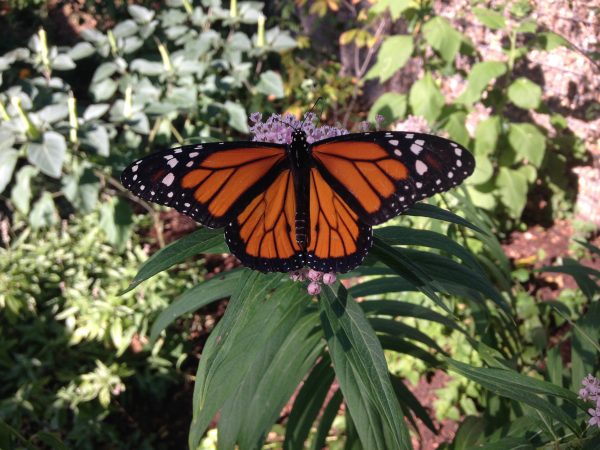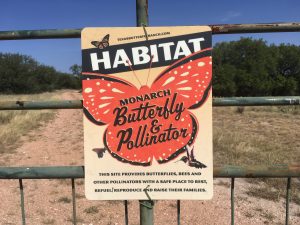Way to go, pollinator habitat fans! You rallied to help us surpass our goal of 500 habitats pledged by 2020. As of this writing, the San Antonio-based initiative brags 510 gardens pledged.

Monarch butterfly nectaring on Swamp milkweed, Asclepias incarnata, in a downtown San Antonio pollinator garden. Photo by Monika Maeckle
The effort known as 500 by 2020 and launched here at the Texas Butterfly Ranch in June of 2019 has its roots in a previous campaign that grew out of he National Wildlife Federation (NWF) Mayor’s Monarch Pledge. The nationwide campaign, launched in 2015, invited mayors along the IH-35 migratory pollinator pathway to pledge to execute up to 24 action items that would increase pollinator habitat in their cities.
In December of 2015, San Antonio became the first city in the nation to agree to act on all 24 recommendations made by the NWF, making it the first Monarch Butterfly Champion City in the country. A citywide pollinator gardening initiative was among the action items pledged. In late 2018, we launched 300for300, an effort to create 300 pollinator habitats for San Antonio’s Tricentennial birthday. We surpassed that goal a year ago with 325 gardens pledged and the community agreed to push for 500 gardens by 2020.
In addition, because of interest outside San Antonio, we expanded the effort beyond the Alamo City. To date, the 510 pollinator habitats pledged include gardens in Guadalajara, Mexico, and Ontario, Canada, as well as California, Florida, Minnesota and many points in between.
See the updated map above for a look at the broad range of pollinator habitats.
The National Wildlife Federation lauded the accomplishment.
“This is a great urban wildlife conservation milestone that benefits monarchs and many other pollinators that are crucial for the survival of all wildlife and people,” said Rebeca Quiñonez Piñón, Monarch Outreach Coordinator for NWF. “Monarch butterfly gardens in San Antonio demonstrate the importance of gardening with native plants, and contribute as well to the well-being of San Antonians —gardening keeps us healthy!”

Broadcast to the world you pollinator habitat’s lofty goals.
It’s never too late to pledge to plant a pollinator garden. You can do so at this link.
To all those who participated and supported our challenge, thank you again, and Happy New Year!
For those interested in creating a pollinator habitat, check out our resources:
Sign up for the pollinator habitat challenge.
Pollinator habitat requirements.
Plant lists and other pollinator gardening resources.
Pollinator habitat signs are available in our shop.
TOP PHOTO: Pollinators welcome: goldenrod, purple aster, cowpen daisies, lantantas and other late season blooms create a pollinator pitstop in downtown San Antonio. Photo by Monika Maeckle
Related posts:
- 300for300 pollinator initiative: 500 habitats by 2020?
- Popularity of pollinator gardens growing in areas prone to drought
- Planting a butterfly garden? Here’s tips on how to do it
- Mostly native butterfly garden outperforms lawn every time
- A year in the life of an urban butterfly garden
- Downtown River walk plot converts to pollinator garden, creature haven
- Converting your Lawn to a Butterfly Garden
- San Antonio becomes first National Wildlife Federation Monarch Champion city
- Tropical Milkweed: To Plant it or Not is No Simple Question
- How to raise Eastern Swallowtails
- How to raise Monarch butterflies at home
Like what you’re reading? Don’t miss a single post from the Texas Butterfly Ranch. Sign up for email delivery below, like us on Facebook, or follow us on Twitter, or Instagram.


Is there a program like this in Houston that anyone knows of? Would someone be willing to share what exactly San Antonio adopted to reach these goals? Or the name and email contact for someone in a San Antonio city department who could help? Thanks,
CONGRATULATIONS Monika and San Antonio! We’ve been following your growth, hoping that others do the same. TOGETHER – WE WILL MAKE A DIFFERENCE!
Please…keep doing what you doing, it’s working!
You, SAN ANTONIO, TEXAS, are making a difference!
THANK YOU…MRM
Fabulous! Way to go San Antonio! It is great to see ordinary citizens making a difference.
I am the newly appointed Landscape Manager for our small gated community in San Antonio. I am trying to implement areas in our community to attract pollinators on some past unused and unsightly corners and walkways. Is there anyone that would be open to giving me specific plant names?